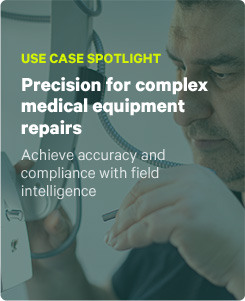Digital transformation in field service has been on the tip of everyone’s tongue ever since the term was coined over ten years ago. It’s no longer a nice-to-have option for field organizations—it’s table stakes. Things have been moving fast over those 10+ years. The future is here now.
TrueContext’s VP of Client Success and Operations spoke at Copperberg’s Field Service US Virtual Summit 2021 to provide his insights on this critical topic. In this jam-packed session, he shared what he believes are the drivers for digital transformation in the field and spoke to several transformational catalysts. Aly also presented TrueContext’s digital maturity model, which we use to help our customers succeed in their efforts.
What is digital transformation?
Aly began his session by defining what digital transformation is and isn’t. He then covered the roadblocks that larger enterprises face when they try to enact change and modernization within their organizations.
What it is. Digital transformation is achieved when an organization integrates people and digital technologies into business operations such that its evolving market and business needs are met in a coordinated and timely manner. The result is a competitive advantage — a new value proposition supported by a new business model delivering net new products and services.
What it isn’t. Change is not transformation. Transformation only occurs when one redefines existing business processes to operationalize a future transformative vision.
The first step in the transformation journey is to find a better way of doing what you’re doing today while retaining your value proposition and business model. The results are more excellent value and better business outcomes, including higher NPS, increased loyalty and customer satisfaction, and more.
What’s the holdup? In “The IT Roadmap for Digital Business Transformation,” Gartner states, “… the transformation journey is taking larger enterprises especially at least twice as long and costing twice as much as they originally anticipated. In large part, this is due to cultural readiness — 53% of the organizations surveyed remain untested in the face of digital challenge and their digital transformation readiness therefore uncertain.”
Culture is key.
What drives digital transformation in the field?
According to Aly, two significant catalysts for transformation are people and technology. A new one, customers, has emerged on the scene recently. Understanding the customer experience has changed the traditional paradigm of what drives digital transformation in the field.
People
The fundamental first step is considering your people as transformation catalysts, in this case, your field service technicians and field service engineers, as well as the field team who support them, such as operations, IT, and citizen developers, among others.
You need to understand the field technician’s requirements and what a day in their life is like. It’s important to acknowledge the difference in how they approach their work and attend to their well-being to ensure satisfaction. We see that their fulfillment with their job is strongly correlated to the satisfaction of your customers, so this certainly does have an impact on everyone.
In addition, their readiness is a crucial area for you to explore with your digital transformation efforts. Look at how you can help them be more productive and optimize their day-to-day tasks. Preparing them for these tasks ensures they succeed and feel positive about their work. Giving them a way to skill up via just-in-time training is another way to set them up to help you drive your transformation goals.
Technology
Technology is the second fundamental pillar of digital transformation. Aly noticed a trend towards ‘digital ambition,’ which focuses on the ability to embrace existing and emerging new technology and how much risk tolerance is accepted when doing so. If the goal is to transform, how far is too far when changing what you’ve been doing and then looking at what you will do in the future?
TrueContext’s Digital Maturity Model
TrueContext has created the Digital Maturity Model to help our customers assess their maturity level related to digital transformation. Four main pillars to this model increase in complexity relative to how accomplished a company is in its efforts. Here’s a top-level look at what’s involved.
Envision. At this point in the continuum, it’s essential to define the outcomes. Ask what you’re attempting to influence through this transformational endeavor. The first step we embark upon with our customers at this stage is process mapping.
Aly suggests one does this from an IT and business perspective. The business will define the future outcomes it wants to establish. Process mapping is a great way to bring in elements of the business and IT to gain clarity on new sets of processes and the different steps it wants to complete. This period provides an excellent opportunity to pull in elements of design thinking with co-ideation and co-creation before you build a solution. As a vendor, we work with our customers in this capacity and encourage them to collaborate within their teams internally as well.
If you’re looking to go further into this topic, especially as it relates to data, please consult the on-demand recording of this session. It provides guidance based on the Four V’s of data surfacing and primes you even further for your efforts around data management.
Engage. Here’s where that earlier mention of people as a catalyst takes center stage. It’s now time to look at the people who are being pulled into this conversation related to mapping out the new way of defining processes and how field service work gets done in a timely way. In addition, one must take advantage of this chance to overlay different processes that help generate revenue as part of a new workflow. Building convergence around workflows and providing field service tasks is the aim here.
At the engagement stage, it’s also critical to consider the mission to align IT with the line of business team. An ideal way to accomplish this is by enacting a shared partnership or responsibilities based on business needs. Rather than investing in the tool first and attempting to bend the business to match its capabilities, it’s best to place the technology solution in front of a technology adoption or steering committee and have them examine how it can best drive innovation.
Execute. Once the company has moved forward in its transformational roadmap and agenda, it’s time to build the solution. In doing so, best practices are being defined to ensure future solutions adhere to this standard. It’s the time to stand up centers of excellence to flow information and requests for information through a very focused and responsible group that understands how mission-critical these solutions are.
It is also the ideal time to remind individuals and the organization as a whole of why the company is pursuing digital transformation and how these changes are connected to positive outcomes to drive new business value for the company. A positive side effect that follows is the profound enhancements to the customer’s experience.
Enhance. We’ve reached the final stage of maturation for digital transformation. Once a subset of the transformation has been deployed, it’s time to continue to drive an additional level of sponsorship across the company’s leadership. It’s essential to ensure strong committees are built with the dual mission to drive future adoption of technologies while also keeping an eye on the horizon for any signs of coming disruption within the industry.
Conclusion
We’ve only touched the surface of the profound insights to be gained from Aly’s talk at Copperberg’s Field Service US Virtual Summit 2021. If you’re interested in taking a deeper dive into this topic, including his thoughts on transformational leadership, and digital dexterity.



